Shared value was first introduced by Michael Porter and Marc Kramer in their Harvard Business Review article in 2011. Since then, multiple industries have assessed how to implement shared value into their business practices.
In other industries, companies need to work hard to find a public good that they can commit to working toward, however, core to every single biopharmaceutical company’s business model is the simple idea of creating therapies to help people in need. Patrik De Haes, M.D., CEO, Oxurion, says once the technical scientific language and complicated 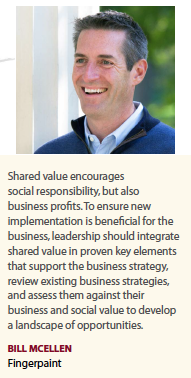 regulatory issues are stripped down, the one goal each company ultimately shares is: to give people a better quality of life. “This makes life-sciences companies’ role in creating shared value unique and gives us the opportunity to be ahead of the curve when it comes to creating shared value," he adds.
regulatory issues are stripped down, the one goal each company ultimately shares is: to give people a better quality of life. “This makes life-sciences companies’ role in creating shared value unique and gives us the opportunity to be ahead of the curve when it comes to creating shared value," he adds.
A Shared Vision for the Future
Life-science companies today are putting shared value statements on their websites for the public to see and publishing case studies on how they create shared value. “As far as making this an everyday practice that is widespread throughout the company, less evidence is seen," says Bill McEllen, head, Saratoga office, Fingerpaint. “While we are moving toward a shared value culture, bottom-line profits still rule. This is especially true in smaller organizations that have tighter budgets and more concerned shareholders. It’s hard for corporate leadership to imagine that their profits will increase if they focus on the greater good of the community as opposed to selling more product.
As more case studies on the benefit of shared value arise, this will hopefully encourage more leaders to take this approach. It is hoped that shared value will not just be another business fad, but a concrete foundation where companies can grow and employees can feel proud of the work they do. They will not only be providing medicines for people, but also creating education tools, working in environmentally friendly practices, and helping those who need it most get access to care. Healthcare reform has been a widespread 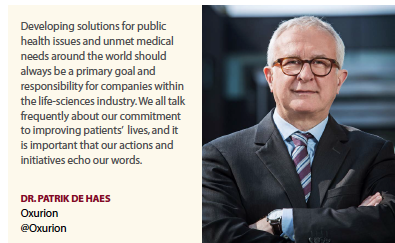 debate in our country, and creating shared value helps enable a pharma company to keep all its stakeholders happy."
debate in our country, and creating shared value helps enable a pharma company to keep all its stakeholders happy."
Other thought leaders agree that the industry is only at the beginning of tapping the full potential of shared value in the life sciences. “Shared value is best leveraged through communities focusing on shared goals," says Randall Hein, president of Advarra Consulting. “At Advarra, we find our partners to be very interested in going beyond transactional vendor relationships to true partnerships with shared value objectives.
Right now, we see this generally limited to sharing value between a limited number of organizations, but we expect this trend to grow as technology continues to facilitate the exchange and use of data across multiple platforms and sources and as more companies see the economic and societal benefit in a shared value approach."
“I believe that in the next five to 10 years, the life-sciences industry will become even more committed to creating shared value and working toward public health initiatives," Dr. De Haes says. “If we want to do good for our patients, it is essential that we all become involved in this effort."
Drew Deeter, president of DeeterUSA, says shared value is a term that marketers have been looking at and debating for some time. It is a term that goes beyond what many refer to as social responsibility, and one that today many are identifying with social purpose.
“The question those of us who market to and through the pharmaceutical industry face is how to address these terms effectively, to build bridges, followings, and relationships 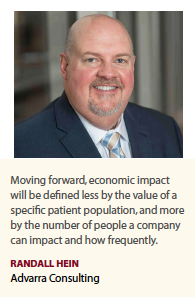 that will see us through good times and bad moving forward," Mr. Deeter says. “People are now beginning to realize we must reshape and balance our business practices with social responsibilities and we had better do it quickly if we intend to realize sales and profit objectives. Maximum business success is not going to happen moving forward unless or until we put our corporate social purpose and its expected social impact or outcome first. Businesses today have to be very clear about what they stand up for and what they believe in. Change leaders and change makers must better understand and serve their culture, environment, society, and those in need if they hope to have any chance of standing out from their competition. Just paying lip service to the world’s problems no longer works. We must balance our economy and ecosystem. Society wants more. And offering superficial responses to the world’s problems — social working — is no longer socially acceptable."
that will see us through good times and bad moving forward," Mr. Deeter says. “People are now beginning to realize we must reshape and balance our business practices with social responsibilities and we had better do it quickly if we intend to realize sales and profit objectives. Maximum business success is not going to happen moving forward unless or until we put our corporate social purpose and its expected social impact or outcome first. Businesses today have to be very clear about what they stand up for and what they believe in. Change leaders and change makers must better understand and serve their culture, environment, society, and those in need if they hope to have any chance of standing out from their competition. Just paying lip service to the world’s problems no longer works. We must balance our economy and ecosystem. Society wants more. And offering superficial responses to the world’s problems — social working — is no longer socially acceptable."
If a company and its management expect to do more than just survive in this new world and want to be taken seriously, they had better read the warnings, switch out their priorities, and start playing an active role in helping to change the world in which they operate and live, Mr. Deeter adds. Leaders need to stop being timid about those things in society they do and do not believe in. They need to step up, voice their opinions, have the background and facts to defend their position on critical issues, and become both social thought and change leaders who act on their beliefs and don’t just talk about them.
Finally, they must be willing to insert their own time, talent, and capital to demonstrate their willingness to make a difference. Unless or until they do this, joining shared values and corporate social responsibility as social purpose has little chance of actually happening.
“My sense is that corporations and their leaders who are willing to step forward and take 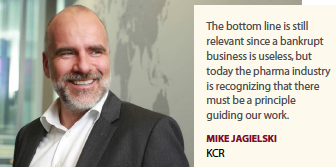 calculated risks will soon become the thought leaders everyone follows," Mr. Deeter states. “Their products and services will become the new industry standards everyone will promote and rally around. This is why having social purpose is so important now. It results in real social change."
calculated risks will soon become the thought leaders everyone follows," Mr. Deeter states. “Their products and services will become the new industry standards everyone will promote and rally around. This is why having social purpose is so important now. It results in real social change."
Mike Jagielski, president and CEO of KCR, charts the industry’s progress in terms of achieving a shared value at about halfway. “Certainly, we are moving in the right direction, but there is still a long way to go," he says. “Today companies, big and small, are changing their approach to business because they undertstand the benefits of shared value. Yet, in many parts of the value chain the profit mindset persists, and a lot of work is needed to convince partners of the importance of collaboration. I am convinced many players are using a wait-and-see strategy to figure out exactly where the industry is going. Once the trailblazers demonstrate success others will jump into and start moving in this direction. In that sense, most likely in 10 years we will see this as a standard business practice."
According to Mr. McEllen, by integrating their contributions to society into their corporate missions, top pharma performers apply shared value at their core and differentiate their work from philanthropy and being a good corporate citizen.
“Traditional philanthropy — donating a portion of profits to meaningful causes — has its limits," he says. “By connecting business success with social progress, companies establish a clear relationship between being successful and doing good."
In addition to donating a portion of their proceeds to nonprofits and patient advocacy groups, companies are providing education, training, and improved care. “Transforming business practices around shared value gives purpose to the corporation," Mr. McEllen says. “In today’s business environment, where the bottom line often rules our thoughts and priorities, ensuring that the greater good is also top of mind guarantees more sustainable, long-term success."
A couple of decades ago, the main driver for the industry was profits. “There was little space for anything else," Mr Jagielski says. “The bottom line is still relevant, since a bankrupt business is useless, but today the pharma industry is recognizing that there must be a principle guiding our work. It is certainly not easy, and it involves making strategic choices that might seem counterintuitive, but it is in our best long-term interest to assume a wider understanding of value than the previous paradigm limiting to profit."
In today’s business environment, specifically in the biopharmaceutical industry, Dr. De Haes says it is becoming increasingly important to show both investors and patients that 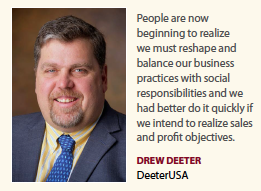 companies care about solving the world’s medical and health problems in addition to making a profit.
companies care about solving the world’s medical and health problems in addition to making a profit.
“For a long time, biopharmaceutical companies focused purely on financial success, often without considering how that success might affect patient lives," he says. “It is essential that the life-sciences industry work against this stereotype and demonstrate to all stakeholders that we are strongly committed to creating social change."
For Sam Osman, CEO of Cenduit, creating shared value allows all stakeholders to redefine productivity and develop a process that allows all patients to get medications at a reduced cost while still maintaining corporate growth and innovation and providing shareholder value. Mr. Osman suggests that pharma take a page from the U.S. auto industry. “During the 1970s the big three auto makers — Ford, GM, and Chrysler — partnered with engine, transmission, and component manufacturers to rethink development and manufacturing," he explains. “By working toward shared value and focusing on core competencies, innovation was able to flourish, and the U.S. auto industry was able to compete with cheaper and more fuel-efficient cars from Europe and Japan. The catalyst for the auto industry was emissions regulations and oil prices, not too dissimilar from some of the regulatory pressures and rising drug prices that the life-sciences space is facing today."
Similar elements may be required for long-term sustainable advantages to reinvent corporate vision for shared value. “Corporate curiosity matters," Mr. Osman says.
“Companies that foster a culture of questioning the status quo are often those with best-of-breed innovation and performance. Business models are changing and an ethos of willingness to adapt regardless of uncertainty is important. The market is changing and competitors are too; holding out to change is a sure-fire way to extinction."
Philanthropy and corporate citizenship are very important responsibilities and actions of any organization. However, these activities are not directly integral to an organization’s economic model and often involve independent actions that are not linked with other industry partners. Mr. Hein of Advarra Consulting, says just as organizations function best when working toward a common goal, industries may function more efficiently by focusing on shared value.
Mr. Hein believes shared value begins by looking at broader research needs and challenges that impact the efficiency and quality of research, which ultimately influences the creation of better treatments for disease. “Shared value often means having the ability to share or exchange information between organizations as well as the ability to leverage data from various sources to make the drug development process more efficient and productive," he says. “The recent growth of patient and patient advocate involvement in clinical trial development is a great example of how shared value can improve the business of research while also nurturing a more inclusive healthcare environment."
Biopharma and biotech companies regularly engage in partnerships with advocacy and community groups around the world, which is just one aspect of creating shared value and developing trust. Oxurion, which focuses on initiatives to fight blindness in communities around the world, believes these initiatives and partnerships with advocacy groups add concrete economic value to the company and shareholders. “Partnerships with advocacy groups increase our access to patient communities and enable us to better understand their needs as well as give us the opportunity to potentially recruit more 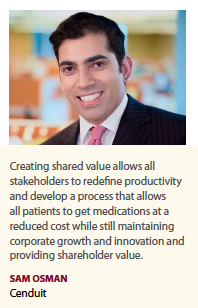 patients into our clinical trials," Dr. De Haes says. “Further, our proven track record of fighting blindness around the world increases clinicians’ trust in our ability to develop drugs to preserve patients’ vision."
patients into our clinical trials," Dr. De Haes says. “Further, our proven track record of fighting blindness around the world increases clinicians’ trust in our ability to develop drugs to preserve patients’ vision."
Shared value, Mr. Jagielski believes is central for the success of organizations in today’s business environment. “Take patient-centricity as an example," he says. “The objective of our work as a CRO is to prolong and improve the lives of people. Once it is understood that patients are at the core of clinical research, we start articulating every activity around this principle."
Creating Models for Shared Success
At Oxurion, the company’s current business model consists of a core public health component.
“We are committed to increasing access to therapies for patients in underserved communities around the world," Dr. De Haes says. “It is also our goal to ensure patients with rare retinal disorders have equal access to innovative therapies. For example, we partnered with Prevent Blindness at the 2018 Focus on Eye Health National Summit to facilitate dialogue around public health issues including vision loss. We have also partnered with Retina Global, an organization with a mission to save the world from blindness, specifically related to retinal disorders. Furthermore, we actively engage in policy discussions with the government to increase patient access to vision-preserving therapies for conditions affecting the back of the eye."
Mr. McEllen outlines three essential elements needed for life-science companies to create shared value: a long-term vision, proper rewards systems, and execution in strategic areas. “Implementing shared value begins with senior leadership crafting an explicit vision of the company as an engine for creating it, including the rationale behind it," he says. “Afterward, key issues are prioritized and agreed on with all members, and buy-in is obtained through participation. To sustain this vision in an environment where short-term profit levels and current share price are the dominant factors in determining compensation, a management system that rewards long-term thinking and performance is needed."
While led from the top, engaging managers from across the company in creating shared value is essential, as it is generated at the business unit level. “This will not occur overnight," he says. “To support adaptation, companies should identify and communicate early successes to help maintain momentum, track progress against goals to keep initiatives on track, and constantly recalibrate and update strategies based on new information. Shared value encourages social responsibility, but also business profits. To ensure new implementation is beneficial for the business, leadership should integrate shared value in proven key elements that support the business strategy, review existing business strategies, and assess them against their business and social value to develop a landscape of opportunities. By comparing opportunities against a set of expected business and social outcomes, companies can prioritize the feasibility of their shared value objectives."
Mr. Osman says if the industry was asked to grade itself on whether it’s gotten drugs to market sooner for patients and made those drugs cheaper, it would be hard-pressed to give itself an A. “The concept of mutual benefit may not be as radically embraced within life sciences as it is within other industries," he adds. “Innovation and services seem to be at odds and a view that one cannibalizes the other when, in fact the two go hand in hand. Flawless service delivery is underpinned by effective leveraging of technology.
Creation of shared value requires mutual benefit and focus on a better end state versus protection of near-term margin. True shared value is created when we have the flexibility to chase every disease versus chasing the ROI on which molecules to advance."
Mr. Jagielski says by adopting an approach that considers the interest of all as your own interest, you force yourself to be more innovative and creative in the way you approach problems. “At the same time, you give yourself the opportunity to implement solutions that require cooperation and joint work with other organizations and entities that would be otherwise impossible to pursue," he says.
Mr. Osman says his company’s vision focuses on absolute principles — tenets that wouldn’t change annually or were based on perceived market forces. “Rather than tying ourselves to specific technologies or approaches we focus on the patient first, and the delivery of care," he says. “Whether we live in an iPhone or Apple Watch world 20 years from now, how we create shared value both upstream and downstream all the way to the patient is what drives our decisions."(PV)
~~~~~~~~~~~~~~~~~~~~~~~~~
Addressing the Issue of Trust
Michael Porter of Harvard Business School, and Mark Kramer, the managing director of the social impact advisory firm, FSG, say companies could bring business and society back together if they redefined their purpose as creating “shared value" — generating economic value in a way that also produces value for society by addressing its challenges. A shared value approach reconnects company success with social progress.
Firms can do this in three distinct ways: by reconceiving products and markets, redefining productivity in the value chain, and building supportive industry clusters at the company’s locations. A number of companies known for their hard-nosed approach to business — including GE, Wal-Mart, Nestlé, Johnson & Johnson, and Unilever — have already embarked on important initiatives in these areas. Nestlé, for example, redesigned its coffee procurement processes, working intensively with small farmers in impoverished areas who were trapped in a cycle of low productivity, poor quality, and environmental degradation. Nestlé provided advice on farming practices; helped growers secure plant stock, fertilizers and pesticides; and began directly paying them a premium for better beans. Higher yields and quality increased the growers’ incomes, the environmental impact of farms shrank and Nestlé’s reliable supply of good coffee grew significantly. Shared value was created.
Shared value could reshape capitalism and its relationship to society. It could also drive the next wave of innovation and productivity growth in the global economy as it opens managers’ eyes to immense human needs that must be met, large new markets to be served, and the internal costs of social deficits — as well as the competitive advantages available from addressing them. But our understanding of shared value is still in its genesis. Attaining it will require managers to develop new skills and knowledge and governments to learn how to regulate in ways that enable shared value, rather than work against it.











